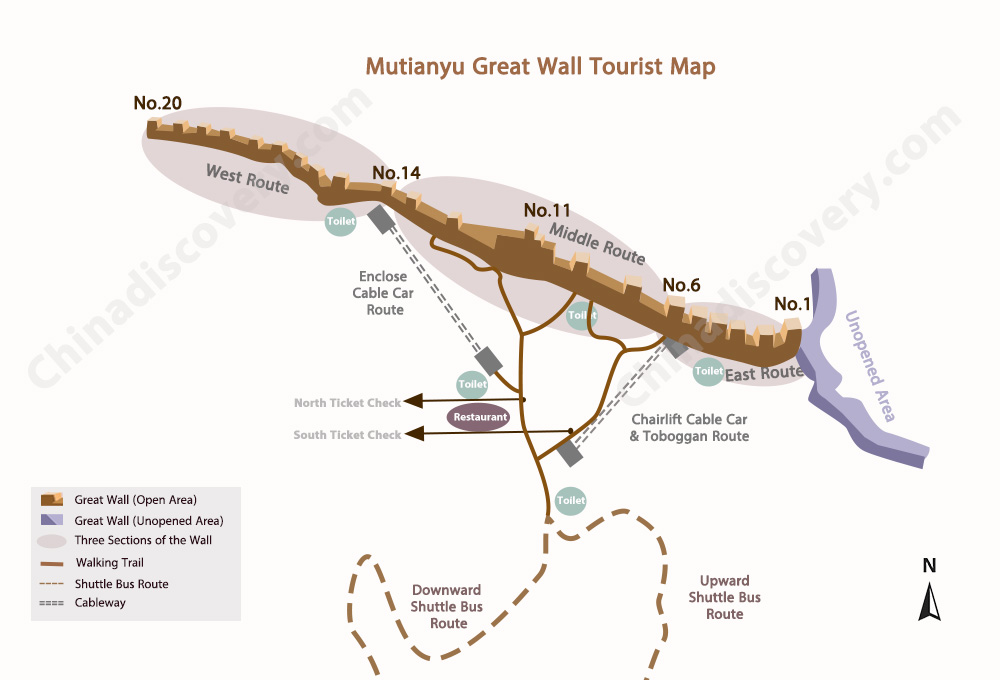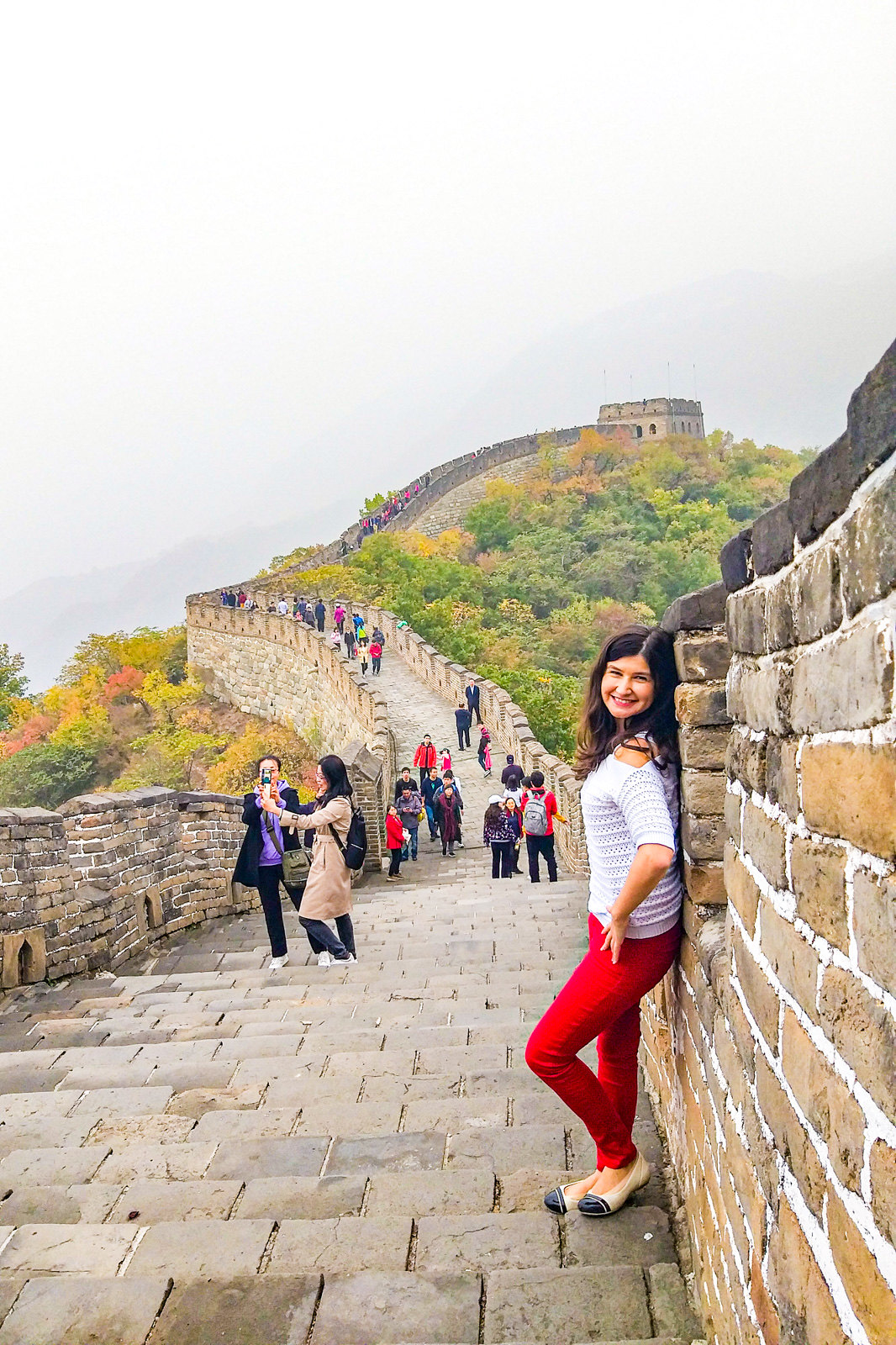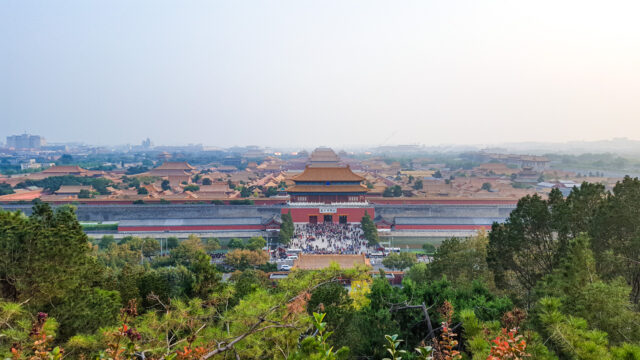Did you know that the Great Wall is spread out across 21 thousand km and you would need about 353 days to complete it without taking into account stops or any complications (obviously this is trivializing it, as some parts are not walkable at all).
Building of the parts of this amazing site started in the 7th century BC. Appr. Around 220BC the unifier of China emperor Qin Shi Huang has ordered to connect these sections in one system dedicated to protect China from attacks from Huns in the north.
Which section of the Great Wall of China should you visit?
I spent quite a lot of time choosing, which section to go to. The options, which are more or less possible to get to using public transport, included Badaling, Mutyaniu and Jinshaling. We were traveling together with mom, so I had to take into account the easy accessibility and walkability, in addition to other things.
Here is the breakdown of the pros and cons of each Section:
Badaling
Badaling is the most visited section of the Wall and the first to be renovated and open for tourists. It was visited by a number of officials. It is easy to reach from Beijing with trains from Huangtudian Railway Station and tourist buses from Qianmen. I believe either way you would need about 1.5. hours to get there. It is served by the cable car.
The downside is that this section is always very crowded. It also isn’t very authentic looking, as the surroundings are too well renovated and to me, has lost its authentic look.
Mutyaniu
Second most visited section of the Wall is Mutyaniu. It is already quite easy to reach nowadays with a number of reasonably priced tourist buses serving it (not needed to join any tours). The buses take up to 2 hours to get there. The section is well renovated and easy to walk, however, still retains its authentic look with views over the surrounding mountains. It is served by a cable car and the tobogan.
The downside is that this section is still quite crowded. It is actually considered the most popular section among foreign travelers, which is understandable.
We chose this option, due to the fact that it’s easily walkable, which would make it possible for mom, and still retains its authentic look.
Jinshaling
Jinshaling section is less renovated, but it is served by the cable car. There is a tourist bus running from Dongzhimen Wai Bus Station and it takes about 3 hours to get there. The main plus is also that this this section the least crowded among the three I considered. It is also considered one of the best preserved with amazing towers and views and with an authentic feel.
However, the main downside is that this section is only partly renovated, so it has uneven steps, loose stones and many rough parts, so you have to be in good shape and careful to walk here.
This would have been my choice, if we were not looking for better walkable section.
Other Sections
I didn’t consider other sections, given that none of them are easily walkable or close to Beijing. You could consider an overnight stay and a 2-day hike from Simatai to Jinshaling, the completely unrestored Jiankou section, Huanghuacheng with lakeside views, etc. If you have more time and are fit, you can consider some of these options instead. But I honestly wouldn’t go to these without seeing the more preserved Jinshaling or Mutianyu first.
Visiting the Great Wall: Mutianyu Section
Mutianyu is the second most visited section of the Wall and the most popular for foreigners. It’s one of the most beautiful sections with lovely views and well-renovated and preserved towers.
When to go to Mutianyu Section of the Great Wall
If you have a while in Beijing, it’s preferable to go during weekdays, rather than on the weekend. However, basically any attractions would be better to visit on weekdays, so it may not be possible. In summer, the Wall would be set in greenery. When we visited in the middle of October, it had beautiful views of yellow leaves. I believe winter would be the worst time, as the trees will be bare and views would not be so beautiful, unless they are covered in snow.
Either way, you may or may not be lucky with the weather. It was foggy on the day we went, so the visibility was not that great, as you can see from the pictures (Beijing was sunny on that day). Probably due to this fact, the crowds were manageable, when we went. Obviously, you never have a chance to find a photo opportunity with no people in it, but it was quite all right.
This is how your photos will turn out, if the day is foggy and visibility is not that great. But it was still nice.
On the other hand, of course, it would be nicer to double check the weather and ensure that there’s better visibility.
How to get to the Mutyaniu Section of the Great Wall
You have several options for getting to Mutyaniu (you can find more info at Beijing Travel’s detailed guide for taking public transport) :
You have an option to get there by public buses – by taking bus 916 and switching to local bus H23 and H24, H35 and H36. This obviously didn’t appeal to us, as it takes a lot of time and effort. So I searched for other options.
Note: Apparently lately they added bus 867 (cost: 16 yuan), which works throughout April to November and is supposed to directly go to Mutianyu. However, I am not sure how reliable this information is. Let me know, if you have taken it and it works.
I hate taking tours and most of them ask for exorbitant prices just to get you to Mutianyu. Taxi would be too expensive as well, particularly, if it waited for us, while we visited the site. Otherwise, finding a taxi back is an almost impossible task.
There are several tourist buses running from different parts of Beijing, including Dongzhimen Tourism bus, Qianmen tourism bus, Zanbus, etc. All of them have certain departure times from Beijing with relevant return times.
The tourist buses are direct buses with no stops at shops or wherever. They directly get you to Mutyaniu. Here is the breakdown of tourist bus options:
- Dongzhimen to Mutianyu tourist bus: The bus runs daily at 8.30 am with the return journey at 4pm. This option at the moment seems to be the best. The ticket costs 30 yuan one way and you get it on the bus paying cash.
- Qianmen to Mutianyu tourist bus: Another good enough option. The main issue with this is however that the bus doesn’t go unless it gets full, so the waiting time can be long from 6.30am to whenever. But once you get to the Wall area, you will have 5 hours to explore, before return journey. Tickets cost 60 yuan for return trip, which is exactly the same, as the previous option.
- Sihui to to Mutianyu tourist bus: Similar as previous buses, the trip costs 60 yuan for round trip. Bus has exact schedule, leaving Sihui at 8am and departing from Mutyaniu at 2.50 pm.
- ZANBUS: The return ticket and admission ticket combination costs 120 yuan. This isn’t the cheapest possible option, but not much more expensive. Major advantage is that it can be prebooked via trip.com.
- MUBUS: the return ticket and entrance ticket combination costs 150 yuan. This is no longer the best option, if you want to save the cost. However, if the guide telling you stories at the bus matters to you and you want the tickets pre-booked, then it may be worth it. You don’t really need to prebook the tickets though, as many people just showed up and bought tickets on the spot, so they added another bus to accommodate everyone.
We used Mubus, due to the fact that at the time of our trip in 2019 it cost 80 yuan (not including admission) and it was the only viable option. If I was travelling now, I would choose Dongzhimen to Mutianyu tourist bus, which seems to be the best option.
If you do go with Mubus, their buses leave from the East side of the of Swissotel Beijing Hong Kong Macau Center. After getting out of the metro stop Dongsishitiao exit C, you should head to your right to the nearest Dongzhong street corner. Across the street, the Mubus employees will stand in their red uniforms and the bus is parked nearby. You will also see Starbucks coffee shop for orientation.
There are buses twice a day at 8am (returning from Mutyaniu at 3pm) and at 10am (returning from Mutyaniu at 5pm). This gives you about 5-6 hours on the spot. I am not sure, if you can take the 8am one and return with the 5pm one though. I guess, it’s worth asking.
I normally don’t like having guides, but Mubus had great guides,, they were not invasive, but made the bus ride interesting. The best thing is that you don’t have to follow them, when you get there, they drop you off and you can go independently until the meeting time.
The bus will drop you off at the bus station. We were told that normally it’s a requirement to pass the small village with stalls, but on the day we were there, this wasn’t necessary and the bus parked at the nearby bus stop, which was great for us, as we didn’t have to walk too much to get to the entrance.
Tickets and the options to go up the Great Wall
The admission ticket costs 45 yuan (with discounts for children, etc). You can get your ticket at the tourist ticket office on the spot.
This map gives you the best overview of where is what. I will explain your choices step-by-step:

You have three options to go up the Wall:
1.On foot, which is free. You can choose between two trails going either to Tower 8 or Tower 10 on foot. We didn’t attempt this, and I don’t think I would in any circumstances, simply because it takes 1-2 hours and has no views. You will need your energy once you are on the Wall.
2. By cable car, which costs 120 yuan return and 100 – one way. To reach the cable car station from the bus station you will have to walk up the steep hill for about 5-10 minutes. This is not very complicated walk, mom managed it quite well.
The cable car goes up to the Tower 14 (see on the map above). This is a higher point than the towers on the east, however the highest point of the whole section is Tower 23, from where the unrenovated wild parts start. From the cable car, you have an option to go left and climb up to the Tower 23, if you are fit and don’t mind a long climb on steep steps. Or you can head to the right, towards Tower 6, from where the chair lift/toboggan can bring you down.
Note: Keep in mind that the cable car going to Tower 14 and the char lift/toboggan for Tower 6 are operated by different companies, so you can’t buy return ticket to take one up and another down. You will have to buy two single tickets in this case.
3. By chair lift (open cable car) up and toboggan down. This option costs 100 one way and 120 both ways. To get to the place, from where you can take it up, you will have to walk up the hill a bit, but the stop is located much downer than the cable car stop. Chair lift goes up to Tower 6. I believe this is the worst option, if you go up only to this section, as it’s neither highest, nor gives access to highest points.
Your options for walking on the Great Wall
Option 1
Go up by the Cable car to Tower 14 and go to your left all the way up to Tower 23. I was told this would take you about 1.5 hours. You will then have to come back to Tower 14 to take cable car down, so keep your energy. This option will cost 45+120 yuans overall. This is also the most beautiful parts of Mutianyu.
We would have chosen this option, if we were not travelling together with mom and had more time at the Great Wall overall. If you do have about 6 hours from the time you get off the bus to the time you return to the bus and if you are suffciently fit, I suggest this option.
Option 2
Go up by the Cable car to Tower 14 and walk to your right to reach Tower 6. From there you can go down by toboggan or the chair lift (open cable car). This option is much easier, but it will be more expensive, as you pay one way for the cable car and one way for chair lift or toboggan separately. Price: 45+100+100 yuans.
Option 3
Go up to Tower 14 and just walk around there. This option is best, if you aren’t very fit and for seniors. You can go to your left and reach Tower 17, which has quite nice views and is not too strenuous to get to. Then come back and stroll to Tower 13 before going back to take the Cable car down. We chose to do this with mom, instead of going all the way to Tower 23 (which we would have done, if we were alone). We actually enjoyed this a lot, as we leisurely strolled along, enjoyed the amazing views and took tons of photos.
Note: Either of the transport options work till 5pm on weekdays, and 5.30pm on weekends (winter hours are half an hour shorter, so be sure to double check).
How easy is it to walk on the Great Wall?
The Mutyaniu section is well renovated and easy enough to walk, however, still retains its authentic look with views over the surrounding mountains. Certainly, it is still not easy for people with mobility issues, who aren’t able to climb any stairs. I was quite worried that mom would not be able to move around here much, but except for several steep steps from the cable car to the wall and the steps to go up the towers (which is not necessary), it was quite easy for her.
The crowds relatively cleared after 5pm, when people headed down I guess not to miss the last cable car. But be sure to be at the cable car stop well before its last departure at 5.30 to make sure you don’t have to walk down.
See also:
Detailed information about other sites in and around Beijing.










I had the pleasure of visiting the Great Wall 3 times when I lived in Beijing, such a marvelous place.
Very informative guide my friend, I love the fact you went into detail about each particular section, each has its own charm!
Glad you found the guide informative 😊
Living in Beijing must have been so interesting. How long did you live there? I would love to explore it more, it’s absolutely fascinating